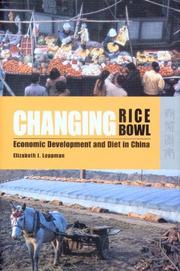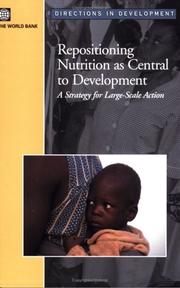| Listing 1 - 10 of 36 | << page >> |
Sort by
|
Book
ISBN: 1282906224 9786612906220 0821384422 0821384414 Year: 2011 Publisher: Washington, D.C. : World Bank,
Abstract | Keywords | Export | Availability | Bookmark
 Loading...
Loading...Choose an application
- Reference Manager
- EndNote
- RefWorks (Direct export to RefWorks)
South Asia has the highest rates of malnutrition and the largest number of malnourished women and children in the world. Childhood malnutrition is the main cause of child mortality-one-third of all child deaths are due to the underlying cause of malnutrition. For the children who survive, malnutrition results in lifelong problems by severely reducing a child's ability to learn and to grow to his or her full potential. Malnutrition directly leads to less productive adults and thus to weaker national economic performance. The negative impact of malnutrition on a society's productivity and a national
Malnutrition --- Nutrition --- Alimentation --- Food --- Health aspects --- Health --- Physiology --- Diet --- Dietetics --- Digestion --- Food habits --- Nutrition disorders --- Starvation
Book
ISBN: 9264272437 9264272429 Year: 2017 Publisher: Paris : OCDE,
Abstract | Keywords | Export | Availability | Bookmark
 Loading...
Loading...Choose an application
- Reference Manager
- EndNote
- RefWorks (Direct export to RefWorks)
- Avant-propos et remerciements - Résumé exécutif - Évaluation et recommandations - Utilité d'une perspective territoriale pour la sécurité alimentaire et la nutrition - Une approche territoriale aux politiques de sécurité alimentaire et nutritionnelle : Étude de cas du Cambodge - Une approche territoriale aux politiques de sécurité alimentaire et nutritionnelle : Étude de cas de la Colombie - Une approche territoriale aux politiques de sécurité alimentaire et nutritionnelle : Étude de cas de la Côte-d'Ivoire - Une approche territoriale aux politiques de sécurité alimentaire et nutritionnelle : Étude de cas du Maroc - Une approche territoriale aux politiques de sécurité alimentaire et nutritionnelle : Étude de cas du Pérou - Constatations au Mali et au Niger.
Food. --- Nutrition. --- Alimentation --- Food --- Nutrition --- Health --- Physiology --- Diet --- Dietetics --- Digestion --- Food habits --- Malnutrition --- Foods --- Dinners and dining --- Home economics --- Table --- Cooking --- Dietaries --- Gastronomy --- Health aspects --- Primitive societies

ISBN: 1282705644 9786612705649 9882200605 9789882200609 9622097235 9789622097230 Year: 2005 Publisher: Hong Kong Hong Kong University Press
Abstract | Keywords | Export | Availability | Bookmark
 Loading...
Loading...Choose an application
- Reference Manager
- EndNote
- RefWorks (Direct export to RefWorks)
The book deals with a topic of perennial interest to Chinese and non-Chinese alike: Chinese food. Chinese culture is exceptionally food-oriented, and non-Chinese are curious about what Chinese people in China actually eat, as contrasted with meals in ever-popular Chinese restaurants.
Habitudes alimentaires --- Alimentation --- Aliments --- Food habits --- Diet --- Food supply --- Approvisionnement --- 5.310. --- Liaoning (Chine) --- Chine --- Liaoning Sheng (China) --- China --- Conditions economiques --- Economic conditions. --- Economic conditions
Book
ISBN: 0407011625 1322201951 1483100308 Year: 1986 Publisher: London : Butterworths,
Abstract | Keywords | Export | Availability | Bookmark
 Loading...
Loading...Choose an application
- Reference Manager
- EndNote
- RefWorks (Direct export to RefWorks)
Alimentation des animaux --- Animal feeding --- Alimentation humaine --- Human feeding --- Santé publique --- public health --- Biotechnologie --- Biotechnology --- 636.084 --- Feeding of animals --- Zoology and Animal Sciences. Animal Nutrition and Feeding --- Animal Nutrition and Feeding (General) --- Animal Nutrition and Feeding (General). --- 636.084 Feeding of animals --- Corps gras animale
Book
ISBN: 9782200244071 220024407X 2200259794 Year: 2010 Volume: *31 Publisher: Paris : Armand Colin,
Abstract | Keywords | Export | Availability | Bookmark
 Loading...
Loading...Choose an application
- Reference Manager
- EndNote
- RefWorks (Direct export to RefWorks)
De la découverte des produits du Nouveau Monde à la naissance du restaurant, l'alimentation en Europe connaît de profondes transformations entre le XVIe et le XIXe siècle. C'est pendant cette période que la culture alimentaire européenne, c'est-à-dire l'ensemble des valeurs et des pratiques liées à l'alimentation et partagées par une large partie de la population, change grâce à l'essor de la circulation des produits et des modes, aux progrès de l'agriculture, à la libération de la gourmandise et aux nouveaux besoins de consommation. Cet ouvrage s'intéresse donc à une histoire en mouvement, où l'échange joue un rôle fondamental dans la construction et la diversification de la culture alimentaire à partir du XVIe siècle. En adoptant une perspective européenne et en mobilisant une historiographie variée, il propose une large synthèse sur l'alimentation à l'époque moderne et ouvre de nouvelles perspectives. Entre consommations et imaginaire, ce parcours historique à travers la diversité du boire et du manger permet de mieux comprendre, en s'intéressant à ses racines, l'alimentation d'aujourd'hui.
Food habits --- Drinking customs --- Habitudes alimentaires --- Boissons --- History --- Histoire --- Fonctions sociales --- AA / International- internationaal --- 331.100 --- 331.20 --- Economische geschiedenis: algemeenheden. --- Sociale geschiedenis: algemeenheden. --- History. --- Economische geschiedenis: algemeenheden --- Sociale geschiedenis: algemeenheden --- Alimentation --- Europe --- 1500-1800 --- 19e siècle

ISBN: 0821363999 9780821363997 9780821364000 9786610306008 1280306009 0821364006 Year: 2005 Publisher: Washington, D.C. : World Bank,
Abstract | Keywords | Export | Availability | Bookmark
 Loading...
Loading...Choose an application
- Reference Manager
- EndNote
- RefWorks (Direct export to RefWorks)
Persistent malnutrition is contributing not only to widespread failure to meet the first MDG-to halve poverty and hunger-but to meet other goals in maternal and child health, HIV/AIDS, education, and gender equity. The choice is now between continuing to fail, or to finally make nutrition central to development. Underweight prevalence among children is the key indicator for measuring progress on non-income poverty and malnutrition remains the world's most serious health problem and the single biggest contributor to child mortality. Nearly a third of children in the developing world are either
Social policy --- Development aid. Development cooperation --- Nutritionary hygiene. Diet --- Developing countries --- Economic assistance --- Malnutrition --- Nutrition policy --- Poverty --- Economic conditions. --- Nutrition --- Government policy --- Alimentation --- Food --- Health --- Physiology --- Diet --- Dietetics --- Digestion --- Food habits --- Health aspects
Book
ISBN: 9252032266 Year: 1992 Publisher: Rome : FAO (Food and Agriculture Organization of the United Nations = Organisation des Nations unies pour l'alimentation et l'agriculture),
Abstract | Keywords | Export | Availability | Bookmark
 Loading...
Loading...Choose an application
- Reference Manager
- EndNote
- RefWorks (Direct export to RefWorks)
AA / International- internationaal --- 050 --- 307.4 --- 338.342.1 --- 338.721 --- 338.722.7 --- 338.722.8 --- 338.724 --- 338.727 --- Voeding --- Landbouw --- Officiële publicaties (per land). --- Productiestatistiek. --- Landbouw in de Derde Wereld. --- Structuur en evolutie van de landbouwindustrie. --- Buitenlandse handel in landbouwproducten. --- Landbouwcrisissen. Landbouwoverschotten en -tekorten. Honger. --- Teelten. --- Veeteelt en producten van de veeteelt en van de visvangst. --- Alimentation/Nutrition --- Agriculture --- Officiële publicaties (per land) --- Productiestatistiek --- Landbouw in de Derde Wereld --- Structuur en evolutie van de landbouwindustrie --- Buitenlandse handel in landbouwproducten --- Landbouwcrisissen. Landbouwoverschotten en -tekorten. Honger --- Teelten --- Veeteelt en producten van de veeteelt en van de visvangst --- Statistique --- Statistics --- Alimentation --- Statistiques --- 20e siecle --- Enquetes

ISBN: 9264286853 9264293035 Year: 2001 Publisher: Paris : OCDE (Organisation de coopération et de développement économiques) = OECD (Organisation for Economic Co-operation and Development),
Abstract | Keywords | Export | Availability | Bookmark
 Loading...
Loading...Choose an application
- Reference Manager
- EndNote
- RefWorks (Direct export to RefWorks)
Cette publication fournit des données sur le niveau et les composantes du soutien et de la protection dont bénéficie l'agriculture, en appréciant l'ampleur des réformes mises en œuvre.
Agrarian question --- Agricultural policy --- Agriculture --- Agriculture and state --- Agriculture--Government policy --- Alimentation --- Farming --- Husbandry --- Landbouw --- Landbouwpolitiek --- Nutrition --- Politique agricole --- State and agriculture --- Voeding --- AA / International- internationaal --- 338.723.0 --- 338.721 --- Landbouwbeleid: algemeenheden. --- Structuur en evolutie van de landbouwindustrie. --- Business & Economics --- Agricultural Economics --- Landbouwbeleid: algemeenheden --- Structuur en evolutie van de landbouwindustrie
Book
ISBN: 0821394517 1475548400 9786613581860 0821395238 1475535937 1280486635 Year: 2012 Publisher: Washington, DC : World Bank,
Abstract | Keywords | Export | Availability | Bookmark
 Loading...
Loading...Choose an application
- Reference Manager
- EndNote
- RefWorks (Direct export to RefWorks)
What has been the impact of yet another food price spike on developing countries' ability to make progress toward the Millennium Development Goals (MDGs)? How many poor people have been prevented from lifting themselves out of poverty? How many people, and how many children, have seen their personal growth and development permanently harmed because their families could not afford to buy food? Finally, what can countries do to respond to higher and more volatile food prices? Global Monitoring Report 2012: Food Prices, Nutrition, and the Millennium Development Goals examines these questions. It
Economic development -- 2001-. --- Economic development -- Developing countries. --- Economic policy -- 2001-. --- Economic policy -- Developing countries. --- Food prices. --- Nutrition. --- Millennium Development Goals. --- Alimentation --- Food --- Nutrition --- Health aspects --- Prices --- MDGs --- Objectifs du Millénaire pour le développement --- OMD (Program) --- United Nations Development Programme. --- Health --- Physiology --- Diet --- Dietetics --- Digestion --- Food habits --- Malnutrition --- Agricultural prices --- Food industry and trade --- Sustainable Development Goals

ISBN: 1280035536 9786610035533 9264192751 9264185577 Year: 2001 Publisher: Paris : OECD Publishing,
Abstract | Keywords | Export | Availability | Bookmark
 Loading...
Loading...Choose an application
- Reference Manager
- EndNote
- RefWorks (Direct export to RefWorks)
Appliances and other electrical equipment increasingly draw power when they are switched off or not performing their primary function. This "standby power" provides remote control capability, network sensing, digital display and other features. Often, standby power is consumed simply because power supplies remain "on" while their appliances are switched "off". Standby power consumption is about 10 per cent of OECD residential energy use or the equivalent of a 60-watt light bulb operating continuously in each OECD household. Standby power consumption can be reduced by an average of 75 per cent with cost-effective design changes and technological improvements. Savings as high as 90 per cent can be achieved in many appliances without any reduction in services. Some products have already achieved very low standby power consumption at little or no cost. But standby power consumption is normally not high enough to command consumer attention. International collaboration is essential to reduce standby power consumption, since so many products and components are traded internationally. Consistent approaches, such as test procedures, standards and voluntary efforts, could also benefit manufacturers by reducing costs and barriers to trade. This book lays out the problem posed by growing standby power consumption, explores fully the technologies available to reduce it, and outlines how increased collaboration among industry, national governments and international organisations can help.
Electric inverters -- Maintenance and repair. --- Emergencies. --- Emergency power supply. --- Emergency power supply --- Electrical & Computer Engineering --- Engineering & Applied Sciences --- Electrical Engineering --- Emergency electric power supply --- Power supply, Emergency --- Power supply, Standby --- Standby power supply --- Electric power supplies to apparatus --- Electric power systems --- Electric power supplies to apparatus. --- Electric power systems. --- Power systems, Electric --- Systems, Electric power --- Electric power production --- Power supplies to apparatus, Electric --- Electric power --- Alimentation électrique de secours
| Listing 1 - 10 of 36 | << page >> |
Sort by
|

 Search
Search Feedback
Feedback About UniCat
About UniCat  Help
Help News
News